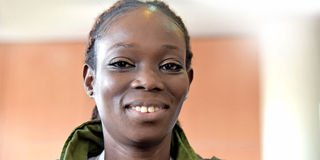Ruth Namusia: Life with sickle cell disease

Ruth Wafula has sickle cell disease. PHOTO| ANTHONY OMUYA| NATION
Ruth Namusia Wekesa was eight when her mother died, exactly a month after delivering Ruth’s younger sister, who serves as her caregiver today.
“At first, I did not know what killed her, but the older I became, the clearer it became that she succumbed to a complication from a sickle cell attack,” recalls Ruth, who has sickle cell disease, a serious chronic medical condition, that she doesn’t allow to define her or get in her way.
“My body only makes sickled haemoglobin and no normal haemoglobin. When normal blood breaks down, it moves easily through the veins, but as my blood breaks down, it looks like sickles or crescent shapes that clog up different parts of the body. The cells are sharp, and that sharpness can cause damage as the blood flow through the body,” she explains.
Even though the shape of her blood cells isn't obvious from the outside, Ruth's sickle cell anaemia is always at the front of her mind, even if she would prefer it wasn't. She does not have the luxury to forget about the extra care the illness requires.
Ruth has been in and out of hospital so many times that the brightly-lit wards, stuffy corridors with a whiff of bleach and double doors with large blue plastic signs of the hospital, have become her second home.
PAIN
Constant pain is a reality for people with sickle cell disease. Patients have red blood cells containing abnormal haemoglobin, the molecule that carries oxygen within red blood cells. And since it is difficult for sickle-shaped cells to pass through small blood vessels, the flow of blood is sometimes blocked and oxygen does not reach nearby tissues. This causes pain, or what is known as a crisis.
Whenever Ruth was in pain, she would seek medical attention, but the doctors always misdiagnosed her. They would prescribe anti-malarial drugs as well as other medication for ailments she did not have.
Her father, a carrier, told her that she was unwell at the age of five. He tried to explain the disease, but she did not understand.
Now at 31, she has spent a great deal of time fighting sickle cell anaemia, and one of the most difficult aspects of the disease is playing the waiting game. Because the symptoms of sickle cell are varied and happen at different points in a person’s life, Ruth does not know which symptoms will strike or when.
Sadly for her, pain was not her only headache. She was constantly taunted by her schoolmates and some relatives for her ill health. The stigma was often worse than the pain, and at one point she was tempted to drop out school.
“You know when you are young, all you worry about whenever in pain is getting better. You put on a brave face. But when you are an adult, you not only have to think about getting better, but also how to pay the bills,” says Ruth.



